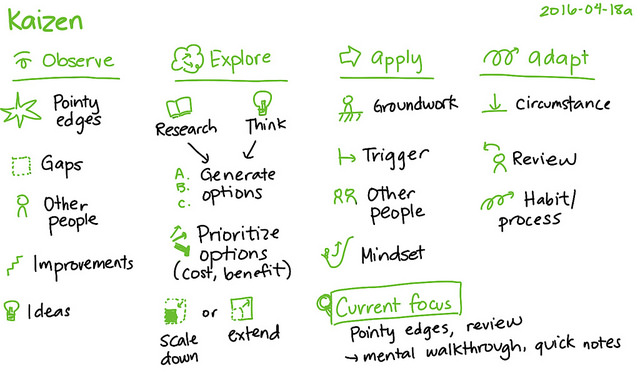Kaizen is a quality system that focuses on continuous improvement. While the application of this system at its inception was the business world, it has transcended to different scenarios. For example, it has been used in several human resources departments with remarkable success.
This system was created in Japan and started from the urgent need that the Japanese people had to get out of the prevailing situation after losing World War II (besides, the island has not many available natural resources and they needed a strong workforce to increase their national industrial productivity.) The success of Japanese quality systems such as Kaizen has revolutionized the industry in East Asia. Countries such as Singapore, Indonesia, China, Malaysia and others have had an accelerated growth due to the adoption of such systems.
The essence of Kaizen is to improve processes by reaching easily achievable goals, tackling conflicts at the very root of them. The continuous improvement is then made through small and large actions on a daily basis. Kaizen is an idea that should be worked every day. It is an individual and group idea that will change the behavior of members of the organization, equipment, etc.
Kaizen may be implemented at management departments, but also by members of quality control circles, waste disposal analyzers and common workers. One of the biggest advantages is that it doesn’t only apply to quality and / or mass production processes: it may be implemented in order to improve the way all employees work in all areas of any company; service and customer care, human resources, marketing, sales, security, logistics, purchasing, and so on.
To carry out the implementation of Kaizen in the workplace is not enough that executives have reports about the current situation of the workplace. It is also necessary to visit the place several times in order to evaluate what it is happening and why.
Any company that wants to implement the Kaizen, either in the manufacturing or the services sector, must start by implementing three key activities: standardization, housekeeping and disposal reductions.
Standardization is basically the best use of every process, making it safer and easier to carry out by workers. It is a productive and effective way to ensure the quality of the product or service and, in consequence, a way for achieving customer satisfaction by creating greater prosperity for the company and its employees.
Housekeeping refers to the “5s”, including a series of Japanese terms that indicate a way to maintain order and cleanliness, achieving better results with routine work and creating greater stimulation.
Waste Disposal consists in eliminating any activities that do not carry implicit value added.
Related: The Japanese concept of feedback: An interesting Human Resources perspective, by Jason Hanold
A key tool is the metrics calculation of process improvement. It involves determining concepts to be improved (eg delivery, quality, productivity, costs, etc.); the unit of measurement to be used for each case (the amount of days for delivery, the number of allowed faults in quality tests, the productivity in terms of man hours, the monetary units for average cost per product, etc.); the current values; the objectives to pursue and the percentages of improvement.
A critical review of conventional production system provides an overview of the basic shortcomings of the usual improved production management and opens new directions for future progress. Although employees have unlimited opportunities to improve workplace opportunities, most companies or organizations tend to believe it is impossible to make further improvements. However, any manager can always carry out substantial improvements in the workplace if the perspectives and approaches are properly changed.

Courtesy of al del barrio at Flickr.com
The continuous improvement cycle that employers must work for helps to avoid installing expensive new equipment, and rather deploying continuous improvements in existing processes. Over time, this approach starts to change the face of the company and the general way of thinking about how to manage production and services. The process is to continually strive to raise product quality and customer satisfaction through a set of small and persistent changes, the kinds of changes that focus on the total elimination of waste.
A systematic kaizen program helps to increase the profits of the company, increasing quality in a way that exceeds the quality of competitors, and to drastically reduce costs and delivery time. In the competitive environment of today, it is more important than ever that all employees of any company not only perform the work assigned to consciousness, but also actively participate in Kaizen activities.
Kaizen methodology requires a strong discipline, enough concentration for improving processes continuously, challenging new brands in terms of quality, productivity, customer satisfaction, cycle times and costs. The success of this technique is due mainly to the fact it includes all employees in the continuous improvement process, and it makes the whole team to actively contribute.
Recommended: Describe the steps in implementation of kaizen in an organization

